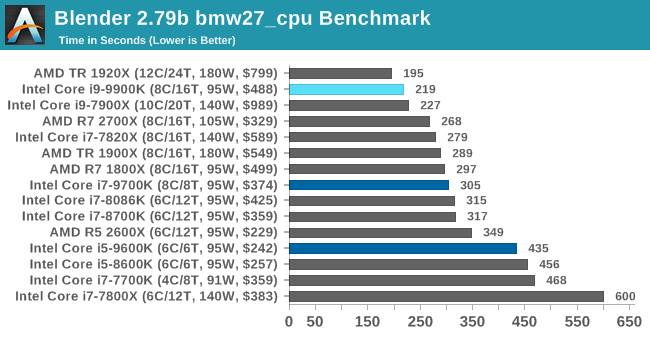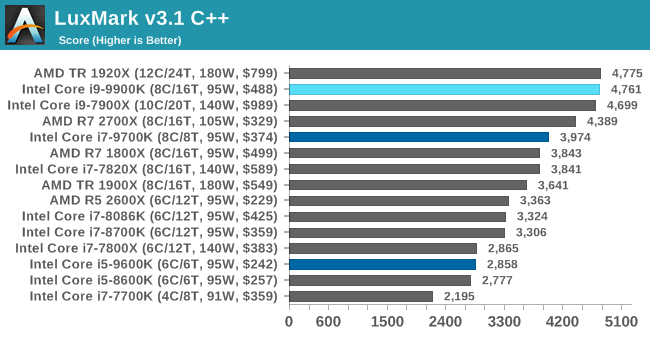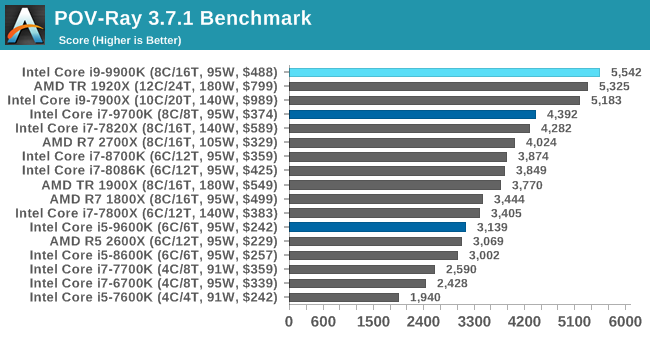The Intel 9th Gen Review: Core i9-9900K, Core i7-9700K and Core i5-9600K Tested
by Ian Cutress on October 19, 2018 9:00 AM EST- Posted in
- CPUs
- Intel
- Coffee Lake
- 14++
- Core 9th Gen
- Core-S
- i9-9900K
- i7-9700K
- i5-9600K
CPU Performance: Rendering Tests
Rendering is often a key target for processor workloads, lending itself to a professional environment. It comes in different formats as well, from 3D rendering through rasterization, such as games, or by ray tracing, and invokes the ability of the software to manage meshes, textures, collisions, aliasing, physics (in animations), and discarding unnecessary work. Most renderers offer CPU code paths, while a few use GPUs and select environments use FPGAs or dedicated ASICs. For big studios however, CPUs are still the hardware of choice.
All of our benchmark results can also be found in our benchmark engine, Bench.
Corona 1.3: Performance Render
An advanced performance based renderer for software such as 3ds Max and Cinema 4D, the Corona benchmark renders a generated scene as a standard under its 1.3 software version. Normally the GUI implementation of the benchmark shows the scene being built, and allows the user to upload the result as a ‘time to complete’.
We got in contact with the developer who gave us a command line version of the benchmark that does a direct output of results. Rather than reporting time, we report the average number of rays per second across six runs, as the performance scaling of a result per unit time is typically visually easier to understand.
The Corona benchmark website can be found at https://corona-renderer.com/benchmark

Corona is a fully multithreaded test, so the non-HT parts get a little behind here. The Core i9-9900K blasts through the AMD 8-core parts with a 25% margin, and taps on the door of the 12-core Threadripper.
Blender 2.79b: 3D Creation Suite
A high profile rendering tool, Blender is open-source allowing for massive amounts of configurability, and is used by a number of high-profile animation studios worldwide. The organization recently released a Blender benchmark package, a couple of weeks after we had narrowed our Blender test for our new suite, however their test can take over an hour. For our results, we run one of the sub-tests in that suite through the command line - a standard ‘bmw27’ scene in CPU only mode, and measure the time to complete the render.
Blender can be downloaded at https://www.blender.org/download/

Blender has an eclectic mix of requirements, from memory bandwidth to raw performance, but like Corona the processors without HT get a bit behind here. The high frequency of the 9900K pushes it above the 10C Skylake-X part, and AMD's 2700X, but behind the 1920X.
LuxMark v3.1: LuxRender via Different Code Paths
As stated at the top, there are many different ways to process rendering data: CPU, GPU, Accelerator, and others. On top of that, there are many frameworks and APIs in which to program, depending on how the software will be used. LuxMark, a benchmark developed using the LuxRender engine, offers several different scenes and APIs.

Taken from the Linux Version of LuxMark
In our test, we run the simple ‘Ball’ scene on both the C++ and OpenCL code paths, but in CPU mode. This scene starts with a rough render and slowly improves the quality over two minutes, giving a final result in what is essentially an average ‘kilorays per second’.


POV-Ray 3.7.1: Ray Tracing
The Persistence of Vision ray tracing engine is another well-known benchmarking tool, which was in a state of relative hibernation until AMD released its Zen processors, to which suddenly both Intel and AMD were submitting code to the main branch of the open source project. For our test, we use the built-in benchmark for all-cores, called from the command line.
POV-Ray can be downloaded from http://www.povray.org/












274 Comments
View All Comments
0ldman79 - Friday, October 19, 2018 - link
AMD needs to improve their AVX processing as well, but they've got Intel in a bit of a predicament.Hifihedgehog - Friday, October 19, 2018 - link
Ladies and gentlemen, I present to you...Intel’s FX 9000 series.
Now even hotter and more power hungry than ever!
mapesdhs - Sunday, October 21, 2018 - link
It reminds me a lot of the P4 days when Intel just had to shove clocks through the roof to remain relevant. And I don't know why tech sites are salivating so much on oc levels that are barely any better than a chip's max turbo, it's a far cry from the days of SB, especially since one can run a 2700K at 5GHz with sensible voltage and good temps using a simple air cooler (ordinary TRUE works fine) and one fan, without high noise (I know, I've built seven of them so far). To me, the oc'ing potential of the 9K series is just boring, especially since the cost is so high that for gaming one is far better off buying a 2700X, 8700K (or many other options) and using the save to get a better GPU.sgeocla - Friday, October 19, 2018 - link
Why compare to the TR 1920x ($799) and not to the TR 2950X ($899)?The TR 2950X kills it in almost every productivity benchmark even against i-9 9900k.
Not even mentioning the 9th gen power consumption.
Yorgos - Friday, October 19, 2018 - link
don't bother with the review.They show you the results that makes intel seem good.
Intel/Purch media have failed to show to the people that they exceed even Threadripper's TDP in order to fight Zen.
Desperate moves for desperate times.
Better look somewhere else for an unbiased review.
mkaibear - Friday, October 19, 2018 - link
What, you mean apart from page 21 where it shows that it almost doubles Threadripper's TDP for the same core count CPU and is 50% greater than the one which has 50% more cores than it does?Some reading comprehension lessons needed I think.
yeeeeman - Friday, October 19, 2018 - link
The 9900K looks like a nice CPU, but damn that power consumption is stupidly high. It is almost twice what the 2700X consumes.Hifihedgehog - Friday, October 19, 2018 - link
*High-end AIO required.AGS3 - Friday, October 19, 2018 - link
Twice the CPU - 8 cores over 5Ghz :)AutomaticTaco - Saturday, October 20, 2018 - link
Revised down. The first motherboard they used was extremely higher voltage settings.https://www.anandtech.com/show/13400/intel-9th-gen...